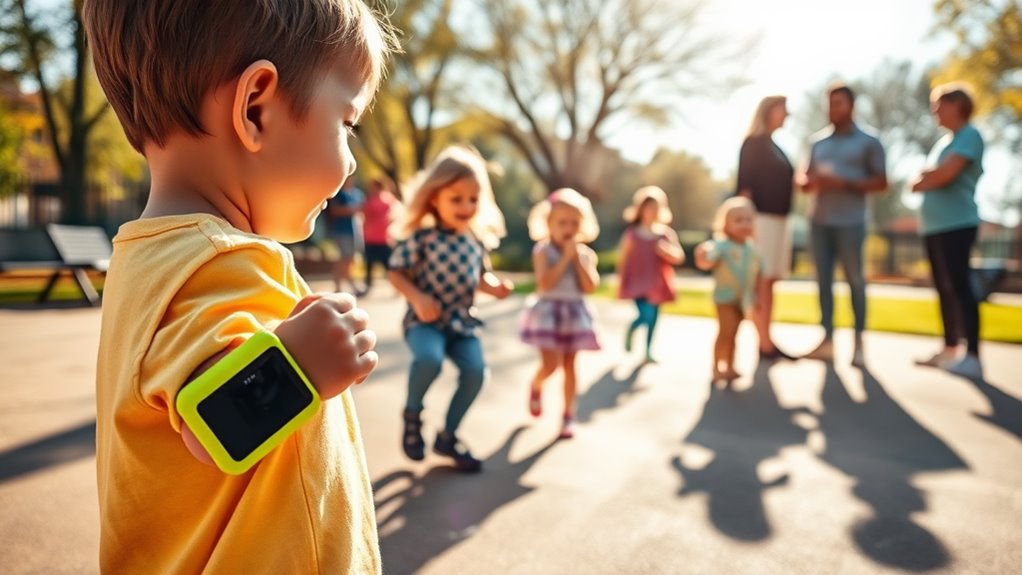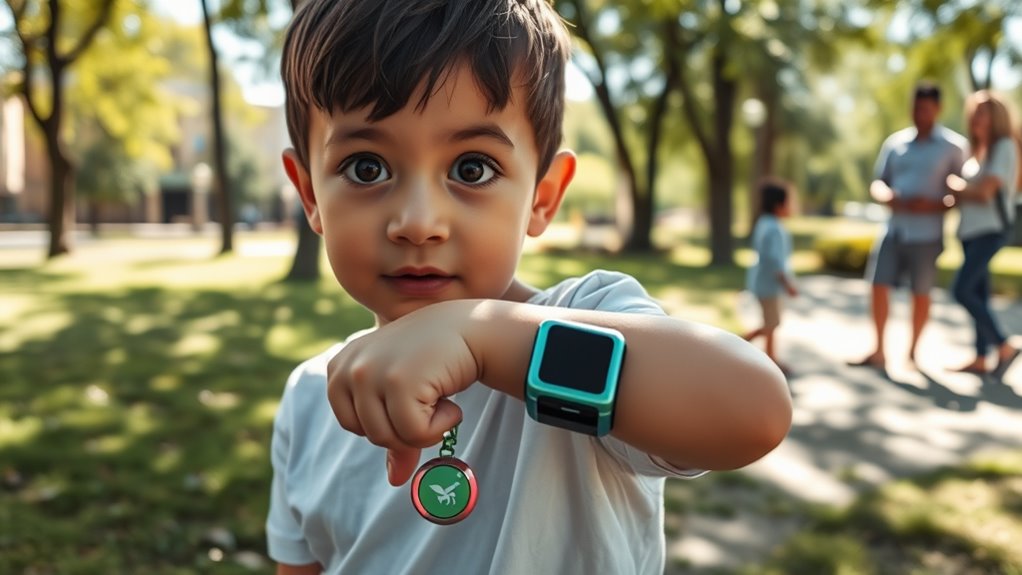Personal alarms for kids can greatly enhance their safety in public spaces. These compact devices allow your child to call for help quickly if they feel threatened. With various types available, like keychain and wristband alarms, your child can choose one that fits their style and comfort. Most alarms emit a loud sound to attract attention and deter potential threats, while some even offer GPS tracking features. It's crucial to teach your child how to use their alarm effectively. By empowering them with these tools, they can navigate public places more confidently. You might discover even more useful tips ahead.
Importance of Personal Safety

In today's world, ensuring personal safety for kids is more important than ever. You need to cultivate safety awareness in your children, teaching them to recognize potential dangers and respond appropriately. Start by discussing safe practices, like staying in groups and avoiding unfamiliar places. Empower them with the knowledge of emergency preparedness; role-play scenarios where they might need to call for help or use a personal alarm. Explain how to seek help from trustworthy adults, and encourage them to communicate openly about their feelings of safety. A personal alarm, such as a keychain alarm with light and sound, can be an effective tool for deterring potential threats. By fostering these skills, you're not just protecting them but also instilling confidence. Consider equipping your child with a 3in1 130db Personal Alarm that features a flashlight and a loud alert sound for added safety in public spaces.
Types of Personal Alarms
Exploring the various types of personal alarms can help you choose the right one for your child's needs. You'll find several alarm styles, each designed with unique alarm features. For instance, keychain alarms are compact and easy to carry, making them perfect for little hands. Wristband alarms offer a discreet option, blending safety with everyday wear. Some alarms emit loud sounds, while others include flashing lights to attract attention. Additionally, GPS-enabled alarms provide real-time tracking, giving you peace of mind. Choose an alarm that suits your child's lifestyle and comfort level, whether they prefer something stylish or functional. Personal Panic Alarm 130dB and Strobe is a popular choice among schools for student safety measures, thanks to its loud alarm sound and bright strobe light. One option is the 2n1 Personal Burglar Alarm, which is compact and portable for easy carrying, ensuring personal security on the go.
How Personal Alarms Work

Understanding how personal alarms work is key to ensuring they provide the best protection for your child. These devices typically feature a simple alarm functionality that activates with a push of a button.
When your child feels threatened or uncomfortable, they can easily trigger the alarm, which emits a loud sound designed to attract attention. This noise not only alerts bystanders but can also deter potential threats.
Some personal alarms connect to smartphones, allowing for quicker emergency response through location tracking and alerts to designated contacts.
Choosing the Right Alarm
Selecting the right personal alarm for your child can make a significant difference in their safety. When choosing an alarm, consider its features and portability. You want an alarm that's easy for your child to carry and use in emergencies.
Here's a quick comparison to guide your decision:
| Alarm Type | Key Features | Portability |
|---|---|---|
| Keychain Alarm | Loud siren, compact design | Easily fits in pockets |
| Wristband Alarm | Vibration alert, stylish | Lightweight, wearable |
| Pocket Alarm | Emergency flashlight, loud | Fits in small bags |
Evaluate these options based on your child's needs and comfort level. The right choice will empower them to feel secure in public spaces.
Teaching Kids to Use Alarms

Regularly teaching kids how to use personal alarms is crucial for their safety and confidence. Start by explaining the purpose of the alarm and how it can help them in an emergency.
Show them the correct way to activate the alarm, emphasizing the importance of quick and effective alarm usage. Role-play different scenarios where they might need to use it, such as getting lost or feeling threatened.
Encourage them to practice, so they feel comfortable and know exactly what to do. Reinforce that using the alarm is a critical part of their emergency response plan.
Remind them that it's not just about the noise; it's about attracting help and ensuring their safety in public spaces.
Frequently Asked Questions
Are Personal Alarms Legal for Children to Carry?
Yes, personal alarms are generally legal for children to carry, supporting personal safety and child empowerment. Always check local laws to verify compliance, but these devices can boost your child's confidence and awareness in public spaces.
Can Personal Alarms Be Customized With Different Sounds?
Yes, personal alarms can often be customized with different sounds, allowing you to choose from a sound variety that matches your preferences. This feature enhances usability and guarantees the alarm is effective in alerting others.
How Long Do Personal Alarm Batteries Typically Last?
Personal alarm batteries typically last between six months to two years, depending on the alarm type and battery maintenance. Regularly checking and replacing batteries guarantees your alarm remains reliable when you need it most.
Are There Age Recommendations for Using Personal Alarms?
When considering age appropriateness for personal alarms, think about your child's maturity and ability to use it effectively. Always follow safety tips, ensuring they understand when and how to activate the alarm in emergencies.
What Should a Child Do After Activating Their Alarm?
After activating the alarm, you should follow clear post-activation steps. Stay calm, find a safe place, and call for help. Always remember the alarm usage guidelines to guarantee you're prepared for any situation.
So Here Is What We Learned
In today's world, keeping your kids safe in public spaces is essential. Personal alarms can be a simple yet effective way to empower them. By understanding the different types and how they work, you can choose the right one for your child. Don't forget to teach them how to use it confidently. With the right tools and knowledge, you're giving your kids a sense of security and the ability to call for help if they ever need it.




